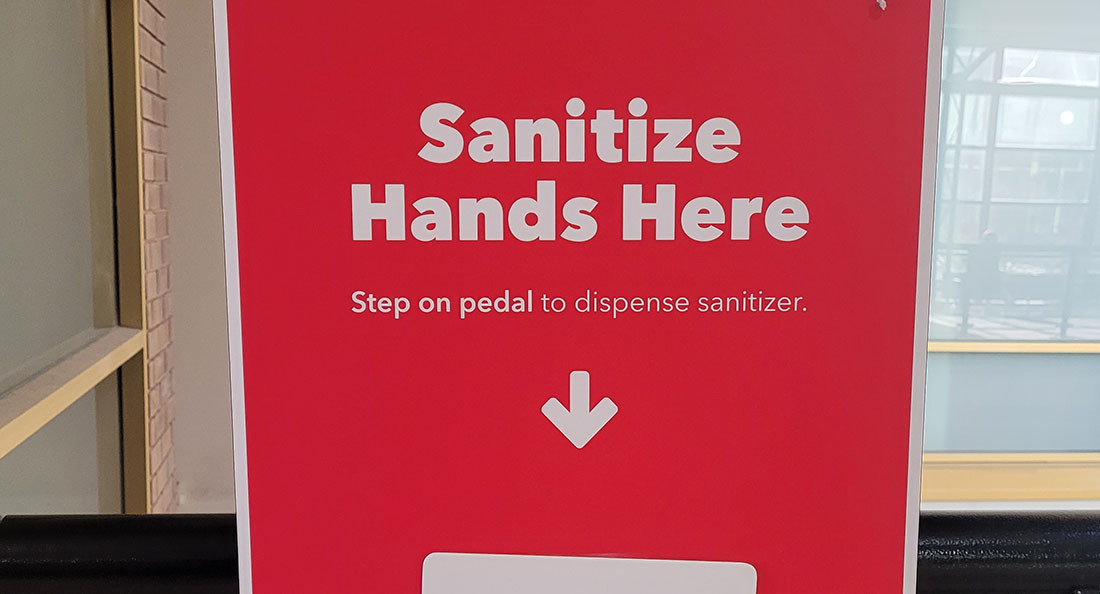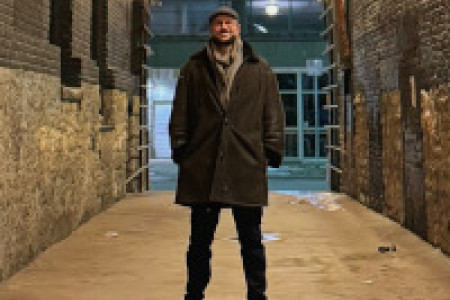‘Avoidable harm’
Some profs, students left behind by U of W’s ‘hands-off’ COVID policy
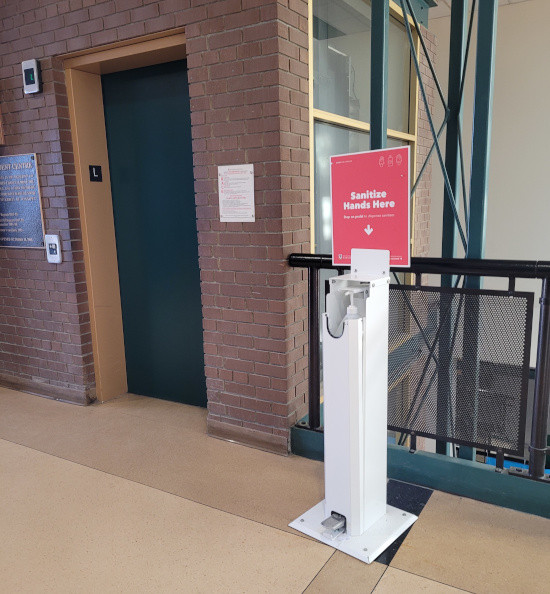
A hand sanitizer next to the elevator outside Riddell Hall - Photo by Thomas Pashko
Masked faces are few and far between as I walk through the University of Winnipeg (U of W)’s main campus in early January, watching as students brush past one another in hallways between classes or congregate around tables in the library’s mezzanines.
Canada Health Infobase wastewater data for Winnipeg’s West End shows COVID-19 viral load reached a six-month high shortly before exam season, increasing over 600 per cent between late September and early November of 2023. But a year and a half after the U of W lifted its mask mandate, most on campus appear to have moved on from pandemic-era precautions like masks and social distancing.
Most – but not all.
Victor Balmana is a third-year theatre student at the U of W. Because he and his father are both immunocompromised, he doesn’t have the option to let his guard down in the way many of his peers have.
“It feels like the people who have moved on are definitely kind of ignorant to the folks who literally cannot move on because of our own immune systems,” he says.
The U of W announced it would require masks on campus on Aug. 26, 2020, trailing behind mask-mandate announcements by Assiniboine Community College (ACC), Red River College Polytechnic (RRC Polytech) and the University of Manitoba (U of M) earlier that month.
The U of W revised its mask requirement to a recommendation in August of 2022, as did an overwhelming majority of institutions across Canada and the United States.
The U of M held on to its mask mandate for the fall and winter terms of 2022-23, a decision that helped convince linguistics student Melissa Curatolo to attend the school. The U of M dropped its mask mandate in May 2023.
These days, Curatolo says it “kind of sucks” being the lone masked student in large classes at the U of M.
“I feel like it does make it harder to try to talk to people, because you’re automatically othered,” he says. “They can’t see your whole face. I don’t care, because I’d rather keep myself safe. But it can feel a little awkward.”
Like Balmana, whether or not to keep masking isn’t a question for Curatolo. For both her and her partner’s sake, she refuses to unmask indoors on campus.
In an Aug. 15, 2022 bulletin announcing a near-immediate end to the U of W’s mask mandate, president and vice-chancellor Dr. Todd Mondor stated that “our top priority continues to be the health and safety of everyone in the UWinnipeg community.”
But with wastewater data indicating that COVID transmission is still widespread, immunocompromised students and faculty are questioning whether the university’s stated prioritizing of health and safety can be reconciled with their experiences of frustration, risk and isolation.
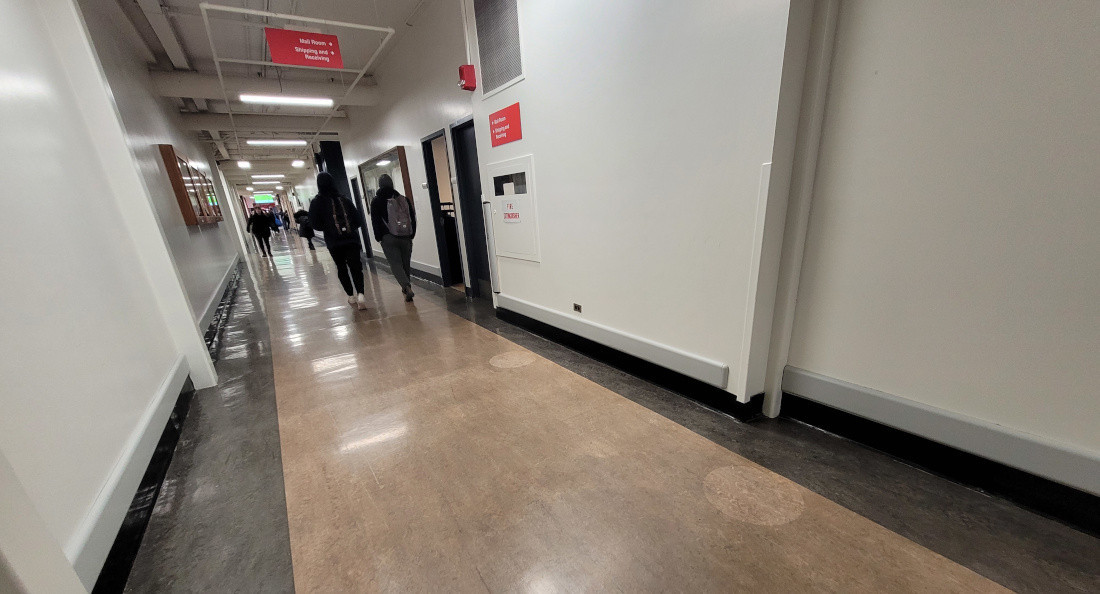
Circular outlines are still visible where social-distancing markers were once placed on the floor in Centennial Hall. - Photo by Thomas Pashko
A delicate balance
In spite of the precautions he takes in his personal and on-campus life, Balmana has contracted COVID at work twice. The first time was while working as a supply attendant at St. Boniface Hospital in February 2021.
“On my first day of training, one of the wards I went to was the COVID ward,” he says. “I’m like, ‘I don’t know if I should be here,’ and I got COVID.”
He picked up his second infection working at the Canada Life Centre over the holidays. School has been comparatively easier to deal with, thanks in large part to Balmana’s theatre professors.
“As a theatre performance major, there’s a lot of active movement and being in contact with other people,” he says. “I was fortunate enough to have a professor who did take (safety) seriously, (who) was able to regulate masks in the classroom and figure out how to adapt our exercises and assignments in a way that was safe for us to do in person.”
Balmana is trans and spends most of his downtime on campus in the Women-Trans Spectrum Centre and the Rainbow Lounge. Even in these spaces he chooses to be in, and whose coordinators actively promote masking and hand hygiene, he says not everyone is as mindful of his access needs as they could be.
“There have been instances in the Rainbow Lounge where it’s been very full and crowded, and some people (are) saying that they feel sick,” he says. “(It) has made me kind of scared, nervous. There’s still people who don’t want to mask, (who) sometimes come in feeling a bit sniffly ... that does make me feel, not necessarily unwelcome, but still kind of barred in a way to enter that space.”
LGBTQ+ people face elevated risks of developing severe and/or long-term complications from COVID. A 2021 CDC behavioural risk-factor analysis shows that LGBTQ+ Americans “have higher self-reported prevalences of several underlying health conditions associated with severe outcomes from COVID-19 than do heterosexual persons.” Moreover, a 2023 International Journal for Equity in Health study reported that trans people face a disproportionate likelihood of developing long COVID after an initial infection.
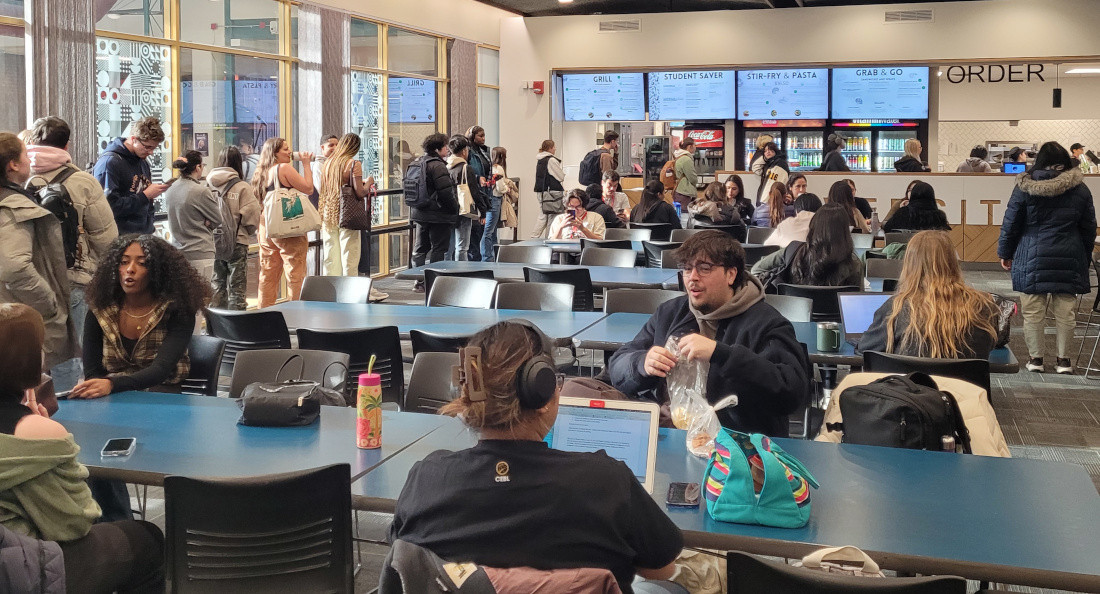
Social-distancing protocols are no longer in place at the Riddell Hall cafeteria. - Photo by Thomas Pashko
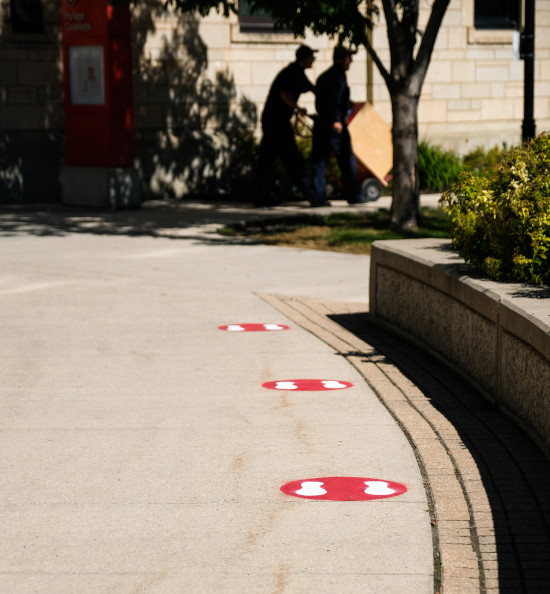
Social-distancing markers on the University of Winnipeg campus. Sept. 5, 2020 - Photo by Daniel Crump
In from the cold
Due to a circulation issue, Curatolo can’t be outside in winter weather for longer than 10 minutes without risking nerve damage. Unable to unmask indoors or stay outside for too long, they often spend long stretches of their days without food or water.
“If it’s minus-30 out, I guess I’ll just, I don’t know, be dehydrated and hungry,” he says. “If everyone wore masks, I’d still (avoid eating) indoors, but it would be significantly safer for people who have to.”
Curatolo sees the deliberate refusal to mask as tying into structures of oppression and “medical violence” that bear down on those with precarious access to healthcare, like disabled people, the queer community and migrants.
“Even if I didn’t have all those other reasons for it, I know this is still killing people,” she says. “I care about elderly people existing or children existing ... or just anyone existing. I don’t want to add to that by inadvertently infecting someone and resulting in death or disability, making their life harder for no reason. I could just put on a mask.”
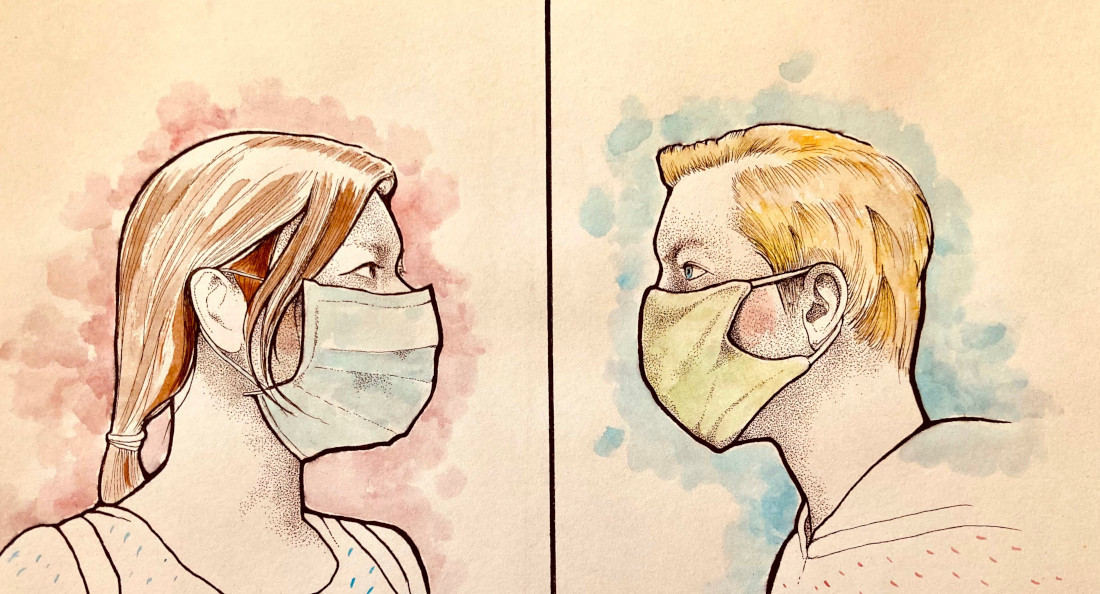
Illustration by Gabrielle Funk
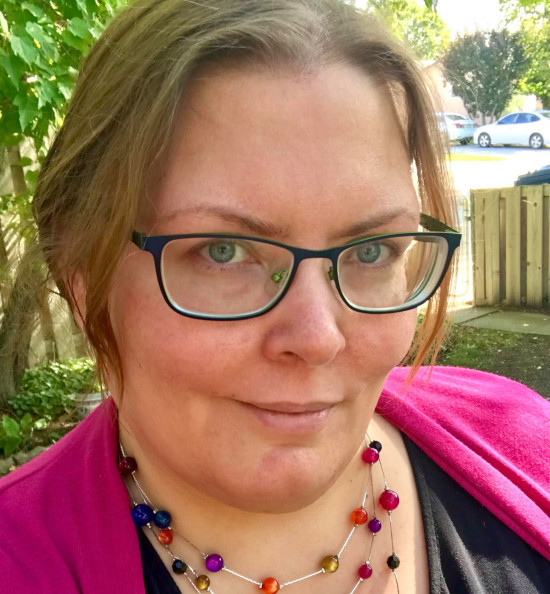
Kristen Hardy, faculty instructor in the University of Winnipeg’s Faculty of Arts - Supplied photo
Profs speak out
U of W physics professor Melanie Martin comes by her COVID advocacy honestly.
“I’m a scientist. I figure all scientists want to know what the science is,” she says. Martin accepts “every media request” she receives about COVID-19 but has curtailed other forms of advocacy after receiving death threats over social media.
“People don’t want to hear it,” she says. “People want the life back from 2019.”
She thinks universities should embrace their role as centres of research to advocate for evidence-based policy, rather than leaving it entirely up to government.
“We’re here to tell people what’s out there,” she says. “We’re here to give them the facts. We should be the ones that are leading things.”
There has been little public criticism of the U of W’s COVID policies in the last year and a half. But behind the scenes, a small group of faculty members has been working to advocate for improved safety measures in classrooms.
Kristen Hardy is a contract instructor in the Faculty of Arts. She was part of the U of W Faculty Association (UWFA)’s COVID committee until the UWFA declined to renew the committee at its Jan. 12 council meeting. Hardy, Martin and others have continued to strategize informally about how to raise awareness.
“The last thing I want as an instructor is to see harm come to any of my students,” Hardy says, “especially avoidable harm, which COVID infections and long COVID absolutely are.”
She says the university could take a number of measures to enhance campus safety, such as giving instructors more autonomy over hybrid/distance learning and mask requirements for their classes. Hardy had to apply for medical accommodation to be able to teach her courses over Zoom on an ongoing basis. U of W faculty do not have the authority to mandate masks in their classes.
“It doesn’t necessarily need to be a single, all-encompassing top-down model,” she says. “There are shades and variations of possibilities there. Right now, we really have almost nothing at the University of Winnipeg.”
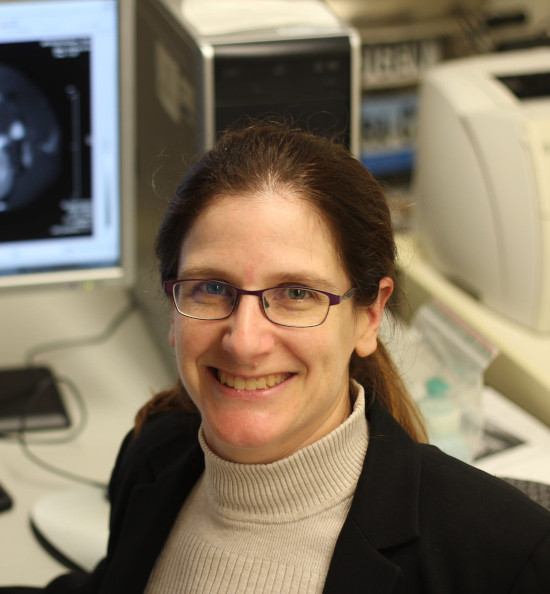
Melanie Martin, University of Winnipeg physics professor - Supplied photo
On Aug. 19, 2021, the U of W, U of M, RRC Polytech, ACC and the University College of the North all announced they would require proof of COVID-19 vaccination for faculty, students and staff to attend campus. CBC reported that the U of W and U of M both relaxed their vaccine requirements in the spring of 2022.
In an emailed statement, U of W communications director Caleb Zimmerman says the institution is “continuing many additional measures that were first implemented during the pandemic.”
These include extra cleaning procedures, on-campus vaccine clinics and enhancement of air filters in high-traffic areas and residence halls.
Zimmerman says the university “continue(s) to rely on guidance provided by Manitoba Health and will continue to follow provincial health guidelines on campus.”
Some of the informal faculty group’s members are reticent about voicing their criticisms of the administration publicly.
One member, a professor in the Faculty of Arts who requested to remain anonymous due to concerns about professional repercussions, wants faculty, students and staff to demand that the U of W stop “forc(ing) us into circumstances where we will be put at risk.”
“The general trend among institutions and other employers is just to take a completely hands-off approach and not do anything,” they say. “That seems to be the thinking of our administration, which is really, really unfortunate, because what that communicates is that they just don’t care.”
“I think you can always tell the values of any organization or any society or any institution by who is most likely to get hurt,” they say. They add that because COVID transmission rates and adverse outcomes are higher for marginalized groups, a hands-off approach undermines the university’s “lofty ideals” of diversity, equity and inclusion.
Another faculty member who requested to remain anonymous says they feel that talking about COVID has become “taboo.”
“Nobody is leading this conversation, because universities across the board are wedded to an ableist model,” they say. “I just don’t think there's enough proactive and positive thinking on how to say, ‘right, this is the reality. This is what we can do to protect everybody.’”
Published in Volume 78, Number 16 of The Uniter (February 1, 2024)

